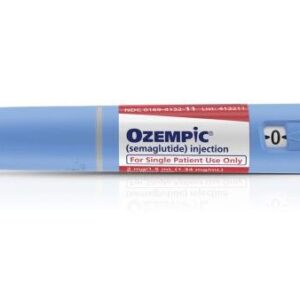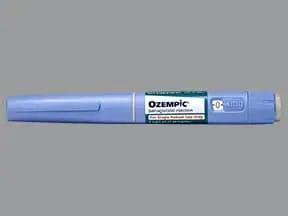Ozempic 8 mg/3 mL (2.68 mg/mL) prefilled pen that delivers 2 mg per injection
Ozempic 8 mg/3 mL (semaglutide) is a GLP-1 receptor agonist used to improve blood sugar control in adults with type 2 diabetes. It is typically prescribed as part of a comprehensive treatment plan that includes diet and exercise. Ozempic is not for use in patients with type 1 diabetes or for the treatment of diabetic ketoacidosis.
The Ozempic 8 mg/3 mL (2.68 mg/mL) prefilled pen is a multi-dose pen that delivers 2 mg of semaglutide once weekly. This is currently the maximum approved maintenance dose for Ozempic and may be prescribed for patients who have tolerated lower doses and require stronger glycemic control.
How It Works:
Semaglutide mimics the body’s natural GLP-1 hormone, stimulating insulin release in response to high blood sugar levels, suppressing glucagon secretion, slowing gastric emptying, and reducing appetite. These effects contribute to better glucose control and may support weight loss.
Dosing and Administration Ozempic 8 mg/3 mL (2.68 mg/mL) prefilled pen:
Each pen contains Ozempic 8 mg of semaglutide in 3 mL of solution (2.68 mg/mL). The pen is designed to deliver four once-weekly doses of 2 mg. Injections are given subcutaneously in the abdomen, thigh, or upper arm. The same day of the week should be maintained for each dose, with or without meals.
This dose is intended for patients who have progressed through lower doses such as 0.25 mg, 0.5 mg, and 1 mg. Dose escalation helps minimize gastrointestinal side effects and improve tolerability.
Storage Guidelines:
Before first use, store the pen in the refrigerator at 36°F to 46°F (2°C to 8°C). After first use, it can be kept at room temperature (not exceeding 86°F or 30°C) or refrigerated for up to 56 days. Do not freeze or expose to direct sunlight or heat the ace ultra.
Important Safety Information:
Ozempic is contraindicated in individuals with a personal or family history of medullary thyroid carcinoma (MTC) or those with Multiple Endocrine Neoplasia syndrome type 2 (MEN 2).
The most common side effects include nausea, vomiting, diarrhea, abdominal pain, and decreased appetite. Serious but rare risks include pancreatitis, acute kidney injury, gallbladder disease, and a potential risk of thyroid tumors.
Clinical Note:
The 2 mg dose delivered from the 8 mg/3 mL pen is used for patients who need intensified therapy after completing dose titration. It should only be used under the guidance of a healthcare provider familiar with semaglutide dosing protocols.






Reviews
There are no reviews yet.